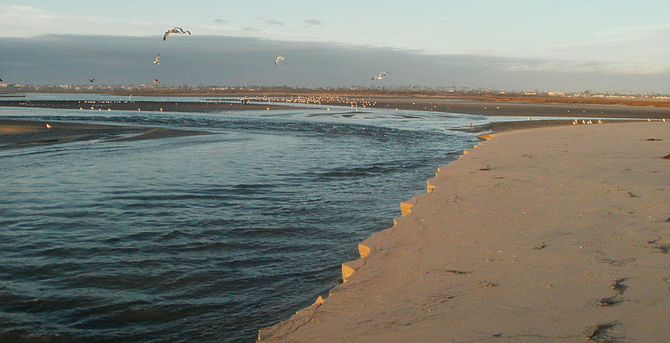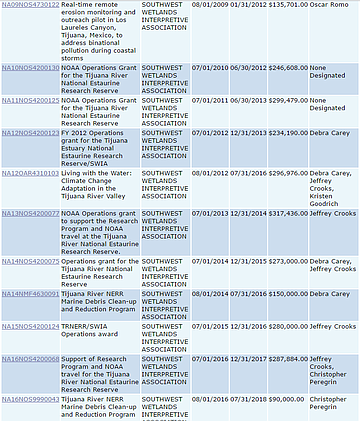 Facebook
Facebook
 X
X
 Instagram
Instagram
 TikTok
TikTok
 Youtube
Youtube

That there was another sewage spill in the Tijuana River estuary last Thursday paled against what’s coming down the federal pipeline.
Federal dollars for programs in the Tijuana River National Estuary Research Reserve are going to disappear if the president's proposed budget is approved — cutting money that supports everything from staff jobs, research, and teaching kids to helping Mexico cut the amount of sewage that comes down the Tijuana River into the estuary.

It was a grim discussion at the estuary's quarterly meeting on March 23, as all federal agencies investing in the estuary (except the U.S. Border Patrol and the U.S. Navy) face cuts under new leadership that appears to scorn the agencies they lead.
State park employees led the discussion and the discussion was cautious and restrained — many federal employees have already been warned to stay silent.
The cuts are for federal fiscal year 2018 — budgets should remain intact until the end of September. And the proposed cuts haven't gone to Congress, where representatives from California are expected to fight to protect funding.
From testing water quality to protecting endangered species to improving wastewater treatment for the Tijuana River in Mexico, much of the money and expertise connected to the estuary is as threatened as the dozen or so protected plants and animals it contains.
The estuary is one of 29 U.S. estuaries “of national importance” in the National Oceanographic and Atmospheric Administration's program that will lose all NOAA funding, part of $250 million in cuts to coastal research and education programs. Allocations of about $23 million for the estuaries are eliminated in Trump's budget.
NOAA grants — for example, a $690,000 grant from last February to study and project climate change effects, and current grants that fund programs training adults to predict and deal with sea-level rise, and bringing school kids to the estuary — are on the chopping block, according to budget documents.
Southwest Wetlands Interpretive Association, a nonprofit that has worked extensively in the estuary, has captured more than $2 million in NOAA grants since 2010 — money that funded staff positions, research and restoration projects, according to NOAA records. The group also won more than $1 million in grants from the EPA and U.S. Fish & Wildlife.
The Environmental Protection Agency is facing a 31 percent budget slash that includes the elimination of its U.S.-Mexico Border infrastructure program — and the termination of about 2,000 EPA employees, according to SaveTheUSEPA.org.
U.S. Fish & Wildlife's parent agency, the Department of the Interior, is facing a proposed 11.7 percent across-the-board cut — minor compared to other cuts. No one is sure where the cuts will land within the department, locally or nationally, officials said.


That there was another sewage spill in the Tijuana River estuary last Thursday paled against what’s coming down the federal pipeline.
Federal dollars for programs in the Tijuana River National Estuary Research Reserve are going to disappear if the president's proposed budget is approved — cutting money that supports everything from staff jobs, research, and teaching kids to helping Mexico cut the amount of sewage that comes down the Tijuana River into the estuary.

It was a grim discussion at the estuary's quarterly meeting on March 23, as all federal agencies investing in the estuary (except the U.S. Border Patrol and the U.S. Navy) face cuts under new leadership that appears to scorn the agencies they lead.
State park employees led the discussion and the discussion was cautious and restrained — many federal employees have already been warned to stay silent.
The cuts are for federal fiscal year 2018 — budgets should remain intact until the end of September. And the proposed cuts haven't gone to Congress, where representatives from California are expected to fight to protect funding.
From testing water quality to protecting endangered species to improving wastewater treatment for the Tijuana River in Mexico, much of the money and expertise connected to the estuary is as threatened as the dozen or so protected plants and animals it contains.
The estuary is one of 29 U.S. estuaries “of national importance” in the National Oceanographic and Atmospheric Administration's program that will lose all NOAA funding, part of $250 million in cuts to coastal research and education programs. Allocations of about $23 million for the estuaries are eliminated in Trump's budget.
NOAA grants — for example, a $690,000 grant from last February to study and project climate change effects, and current grants that fund programs training adults to predict and deal with sea-level rise, and bringing school kids to the estuary — are on the chopping block, according to budget documents.
Southwest Wetlands Interpretive Association, a nonprofit that has worked extensively in the estuary, has captured more than $2 million in NOAA grants since 2010 — money that funded staff positions, research and restoration projects, according to NOAA records. The group also won more than $1 million in grants from the EPA and U.S. Fish & Wildlife.
The Environmental Protection Agency is facing a 31 percent budget slash that includes the elimination of its U.S.-Mexico Border infrastructure program — and the termination of about 2,000 EPA employees, according to SaveTheUSEPA.org.
U.S. Fish & Wildlife's parent agency, the Department of the Interior, is facing a proposed 11.7 percent across-the-board cut — minor compared to other cuts. No one is sure where the cuts will land within the department, locally or nationally, officials said.
Comments